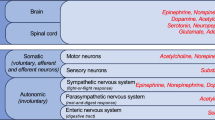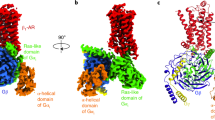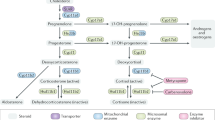Abstract
PHARMACOLOGICAL agents such as dibutyryl cyclic AMP1,2, cholera toxin3,4 and β-adrenergic stimulants5 have an effect on antibody production which can be inhibitory or enhancing, depending on the dose used and the time of addition of the agent. Such stimulants are known to inhibit the human T-lymphocyte receptor for sheep erythrocytes6,7 and the murine lymphoma Fc receptor8, and it has been shown that the complement receptor on B lymphocytes has an important role in the cellular events leading to antibody production9,10, thus emphasising the need to clarify its nature. We report here that the number of complement receptor rosette-forming cells (EAC–RFC) in suspensions of mouse spleen cells can be decreased by α-adrenergic stimulants and increased by β-adrenergic stimulants, respectively.
This is a preview of subscription content, access via your institution
Access options
Subscribe to this journal
Receive 51 print issues and online access
$199.00 per year
only $3.90 per issue
Buy this article
- Purchase on Springer Link
- Instant access to full article PDF
Prices may be subject to local taxes which are calculated during checkout
Similar content being viewed by others
References
Watson, J., Epstein, R. & Cohn, M. Nature 246, 405–409 (1973).
Teh, H. S. & Paetkau, V. Nature 250, 505–507 (1974).
Cook, R. G., Stavitsky, A. B. & Schoenberg, M. D. J. Immun. 114, 426–434 (1975).
Kateley, J. R., Kasarov, L. & Friedman, H. J. Immun. 114, 81–86 (1975).
Braun, W. Ann. N.Y. Sci. 207, 17–28 (1973).
Chisari, F. V. & Edgington, T. S. J. exp. Med. 140, 1122–1126 (1974).
Galant, S. P. & Remo, R. A. J. Immun. 114, 512–513 (1975).
Zuckerman, S. H. & Douglas, S. D. Nature 255, 410–412 (1975).
Dukor, P., Dietrich, F. M., Gisler, R. H., Schuman, G. & Bitter-Suermann, D. Prog. Immun. II 3, 99–109 (1974).
Arnaiz-Villena, A., Playfair, J. H. L. & Roitt, I. M. Clin. exp. Immun. 20, 375–378 (1975).
Bianco, C., Patrick, R. & Nussenzweig, V. J. exp. Med. 132, 702–720 (1970).
Butcher, R. W. & Sutherland, E. W. Ann. N.Y. Acad. Sci. 139, 849–859 (1967).
Butcher, R. W. & Sutherland, E. W. J. biol. Chem. 237, 1244–1250 (1962).
Roberts, G., Richardson, A. W. & Green, H. D. J. Pharmac. exp. Therap. 105, 466–476 (1952).
Black, J. W., Crowther, A. F., Shanks, R. G., Smith, L. H. & Dornhorst, A. C. Lancet 1, 1080–1081 (1964).
Robinson, G. A., Butcher, R. W. & Sutherland, E. W. Ann. N.Y. Acad. Sci. 139, 703–723 (1967).
Author information
Authors and Affiliations
Rights and permissions
About this article
Cite this article
ITO, M., SLESS, F. & PARROTT, D. Evidence for control of complement receptor rosette-forming cells by α- and β-adrenergic agents. Nature 266, 633–635 (1977). https://doi.org/10.1038/266633a0
Received:
Accepted:
Issue Date:
DOI: https://doi.org/10.1038/266633a0
Comments
By submitting a comment you agree to abide by our Terms and Community Guidelines. If you find something abusive or that does not comply with our terms or guidelines please flag it as inappropriate.



